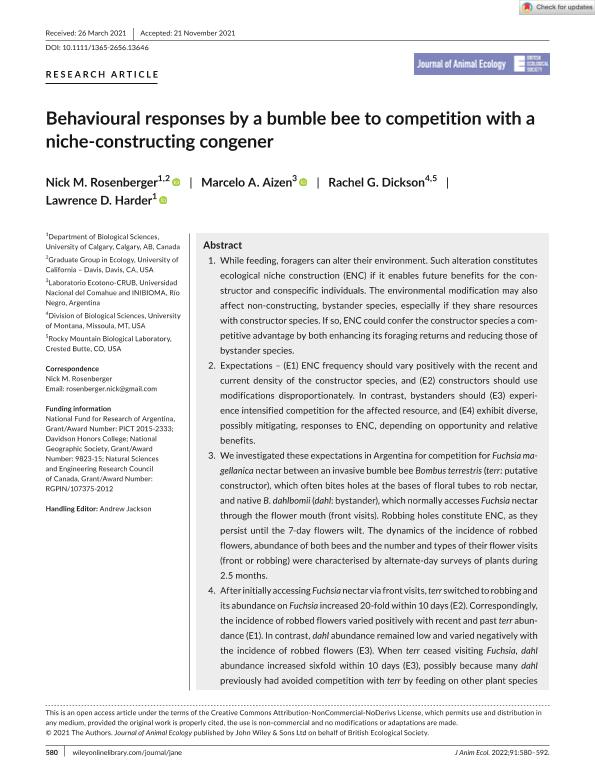Artículo
Behavioural responses by a bumble bee to competition with a niche-constructing congener
Fecha de publicación:
03/2022
Editorial:
Wiley Blackwell Publishing, Inc
Revista:
Journal Of Animal Ecology
ISSN:
0021-8790
e-ISSN:
1365-2656
Idioma:
Inglés
Tipo de recurso:
Artículo publicado
Clasificación temática:
Resumen
While feeding, foragers can alter their environment. Such alteration constitutes ecological niche construction (ENC) if it enables future benefits for the constructor and conspecific individuals. The environmental modification may also affect non-constructing, bystander species, especially if they share resources with constructor species. If so, ENC could confer the constructor species a competitive advantage by both enhancing its foraging returns and reducing those of bystander species. Expectations – (E1) ENC frequency should vary positively with the recent and current density of the constructor species, and (E2) constructors should use modifications disproportionately. In contrast, bystanders should (E3) experience intensified competition for the affected resource, and (E4) exhibit diverse, possibly mitigating, responses to ENC, depending on opportunity and relative benefits. We investigated these expectations in Argentina for competition for Fuchsia magellanica nectar between an invasive bumble bee Bombus terrestris (terr: putative constructor), which often bites holes at the bases of floral tubes to rob nectar, and native B. dahlbomii (dahl: bystander), which normally accesses Fuchsia nectar through the flower mouth (front visits). Robbing holes constitute ENC, as they persist until the 7-day flowers wilt. The dynamics of the incidence of robbed flowers, abundance of both bees and the number and types of their flower visits (front or robbing) were characterised by alternate-day surveys of plants during 2.5 months. After initially accessing Fuchsia nectar via front visits, terr switched to robbing and its abundance on Fuchsia increased 20-fold within 10 days (E2). Correspondingly, the incidence of robbed flowers varied positively with recent and past terr abundance (E1). In contrast, dahl abundance remained low and varied negatively with the incidence of robbed flowers (E3). When terr ceased visiting Fuchsia, dahl abundance increased sixfold within 10 days (E3), possibly because many dahl previously had avoided competition with terr by feeding on other plant species (E4). While terr was present, dahl on Fuchsia used front visits (tolerance) or used existing robbing holes (adoption: E4). The diverse dahl responses suggest partial compensation for competition with terr. ENC alters competitive asymmetry, favouring constructor species. However, bystander responses can partially offset this advantage, perhaps facilitating coexistence.
Archivos asociados
Licencia
Identificadores
Colecciones
Articulos(INIBIOMA)
Articulos de INST. DE INVEST.EN BIODIVERSIDAD Y MEDIOAMBIENTE
Articulos de INST. DE INVEST.EN BIODIVERSIDAD Y MEDIOAMBIENTE
Citación
Rosenberger, Nick M.; Aizen, Marcelo Adrian; Dickson, Rachel G.; Harder, Lawrence; Behavioural responses by a bumble bee to competition with a niche-constructing congener; Wiley Blackwell Publishing, Inc; Journal Of Animal Ecology; 91; 3; 3-2022; 580-592
Compartir
Altmétricas




